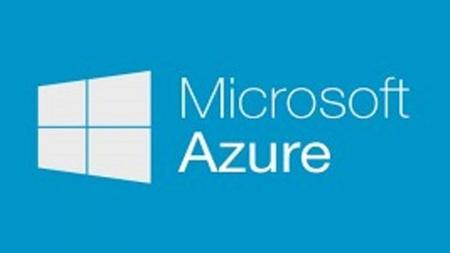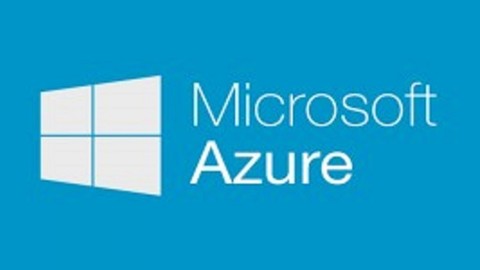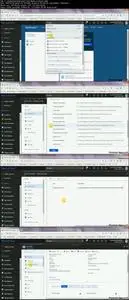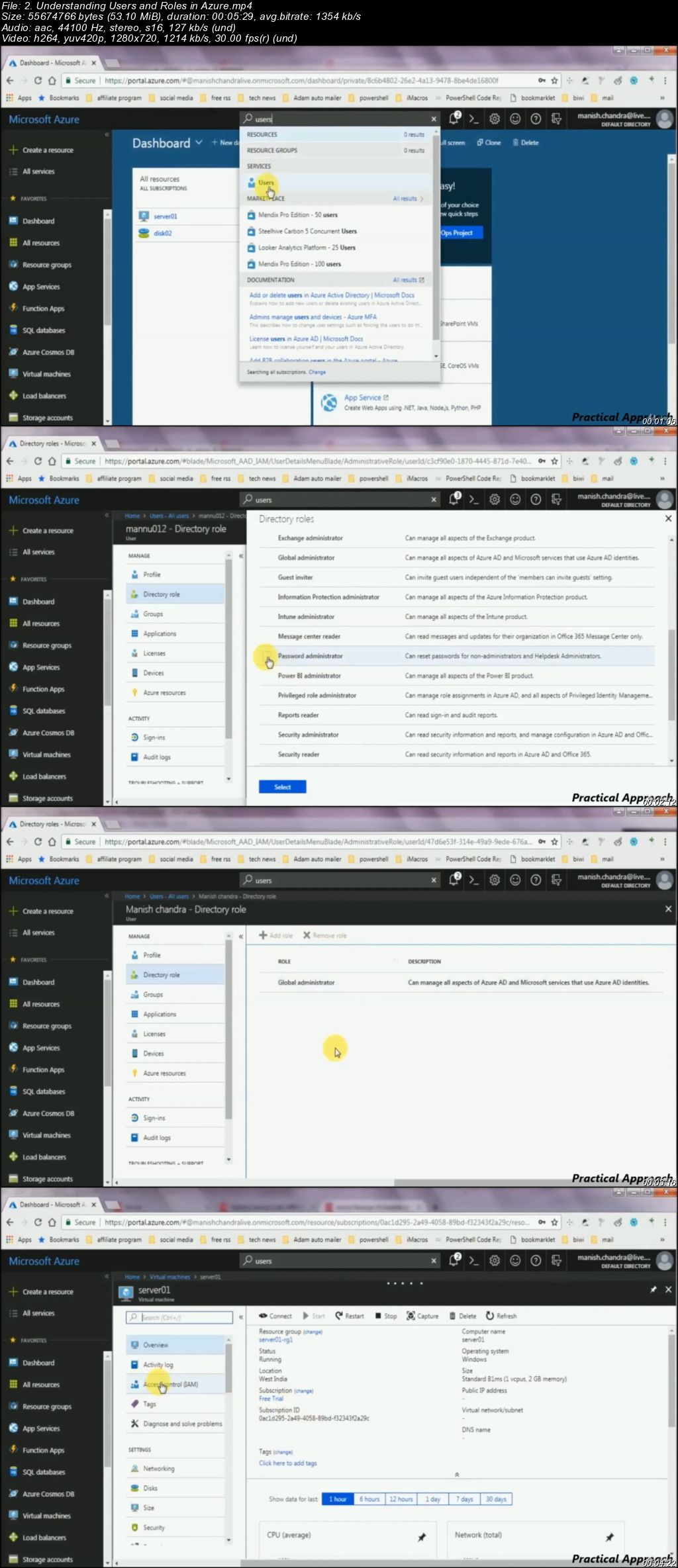Fundamentals of Azure and Powershell
.MP4 | Video: 1280x720, 30 fps(r) | Audio: AAC, 44100 Hz, 2ch | 1.65 GB
Duration: 3 hours | Genre: eLearning | Language: English
Get started with Microsoft Azure in a nutshell
.MP4 | Video: 1280x720, 30 fps(r) | Audio: AAC, 44100 Hz, 2ch | 1.65 GB
Duration: 3 hours | Genre: eLearning | Language: English
Get started with Microsoft Azure in a nutshell
What you'll learn
Clear understanding of cloud computing ,services,models,benefits,disadvantages and analysis
Azure advantages, disadvantages, analysis, datacenters and pricing implementation
Azure marketplace and services concepts
Deploying virtual machines from Azure portal with explanation of each new terminology
Azure users and roles understanding
Azure storage concept and implementation
Azure backup and configuration
Azure powershell tools, context and modules
Azure powershell complex object properties
Step by step explanation and deployemnt of azure virtual machine from powershell
Automation with azure Runbook and Desired state configuration
Azure ARM template explanation and implementation
Requirements
Basic IT knowledge of Networks and Virtual machine
A free or paid subscription to Microsoft Azure
Excitement to learn constantly growing Microsoft Azure platform right from zero
Description
This course is designed to help you get started with Microsoft Azure with a clear understanding about the basics in a simple way. It is focused on providing key concepts of Azure Infrastructure solution to IT professionals.
It will help you to become comfortable with cloud concepts and Azure fundamentals to start developing solutions right away.
It touches both gui and powershell part of Azure cloud solution and will help you to prepare your base for understanding advanced and architect level of Azure solution. The concepts and demos are based on real world situation which IT professionals faces on Azure cloud platform and will provide you all the knowledge and tools necessary to get started with your job in Azure cloud platform right away.
Lecture 1 explains what is cloud computing in detail. It also explains the different types of cloud services i.e. Infrasturcture as a service (IaaS), Platform as a service (PaaS) and Software as a service (SaaS) with eamples.
Lecture 2 explains the different popular services available with cloud computing such as Communications, Data storage, Compute, Network, Platform, Software, Database, Desktop, Email, Identity and Security. Then it explains the different cloud deployement models i.e. Public cloud, Private cloud and Hybrid cloud.
Lecture 3 explains the different uses of cloud computing such as in storage, backup, disaster recovery, email, testing and development. Then it explains the benefits of cloud computing. the different disadvantages of cloud computing. At the end it explains the different analysis scenario that should be considered before moving infrastructure to cloud.
Lecture 4 introduces Azure. It explains what is Azure , the different benefits available with azure and the disadvantages of using Azure.
Lecture 5 explains the network of huge datacenter that is available with Microsoft Azure.
Lecture 6 explainins the cost implementation of using Azure. It explains the different cost that may occur initially once you move to cloud. So one should consider if these costs are affordable for their business or not before moving to cloud. Then it explains imporatnt factors which can help to calculate the cost of moving to Azure effectively. At the end it shows how to use Azure pricing calculator to get an estimate of monthly and yearly bill once you move to azure.
Lecture 7 shows the step by step process to open a free 30 days trial account with Microsoft Azure. At the end it introduces you to the Azure portal.
Lecture 8 explores the Azure portal. It shows the different menus, settings and options available in Azure portal and how you can use them. Then it explores the Azure marketplace website and explains how one can take Test drive in azure marketplace. At the end it again shows some options and settings in Azure portal.
Lecture 9 explains the different Azure services available in Azure portal and what one do with these services.
Lecture 10 shows the step by step process to deploy virtual machine using Azure portal. In the process it also explains the different new terms that appears while deploying virtual machine such as Azure resource manager, Classic deployment model, Premium SSD Disk, Standard HDD disk, Resource group, Availability zones, Availability set, Azure virtual network, Public IP address, Network security group etc.
Lecture 11 explains the Azure users and roles. It shows how you can add users in Azure portal and how to assign roles to users.
Lecture 12 explains Azure storage, the benefits of using azure storage. It explains the different azure storage account types and their sub types such as General-Purpose storage account (Standard storage and premium storage), Blob storage account. It then explains the different data services available in azure storage such as azure blob and the differnt types of azure blob such Block blobs, Append blobs and page blobs, then Azure files, azure queues and then azure tables. At the end shows a demo of how to add storage using Azure portal.
Lecture 13 explains azure backup and the benefits of using azure backup. At the end it shows a demo of how to configure backup in azure.
Lecture 14 introduces you to Azure powershell. It shows how you can use inbuilt powershell in your machine for managing azure.
Lecture 15 first explains the powershell version details needed to manage azure. Then it explains how to configure and use azure cloudshell.Then it shows step by step instructions to install AzureRM module in powershell. At the end it shows how to login and logout from azure in powershell and how to select azure subscription in powershell.
Lecture 16 explains azure context and shows how to use azure context in powershell.
Lecture 17 explains usage of azure powershell command lets and modules in powershell. It explains how to use cmdlets and how to get help with it. It also explains the usage of parameters in Azure powershell.
Lecture 18 explains the usage of objects properties of cmdlets in powershell. It explains how to find and explore the hidden and complex properties by expanding JSON code and how to use them.
Lecture 19 shows step by step process to deploy a virtual machine from azure powershell. It shows how to first create a resource group using powershell, then it goes on showing how to configure virtual network subnet, how to create virtual network, random public IP address, network security group rule, network security group, network interface card using powershell. Then it shows how to specify virtual machine configuration in powershell and how to retrieve and use information such as vm size, source image publisher name, offer details, sku image using powershell. At the end it shows how to create virtual machine using all the configurations previously setup using powershell.
Lecture 20 explains the benefits of automation in azure and the tools such as runbooks and desired state configurations that are available for automating workloads in azure.
Lecture 21 shows how to use a runbook for automating workloads in azure.
Lecture 22 shows how to use desired state configuration for automating workloads in azure.
Lecture 23 explains Azure ARM and ARM template. It explains how the parsing of JSON file of ARM template is done by microsoft to rest API operations. Then it gives a demo of how to create an azure resource manager template.
Who is the target audience?
IT professionals who wants to start their career in Azure cloud platform
IT professionals who wants to enhance their knowledge on azure cloud platforms in simple and practical way





